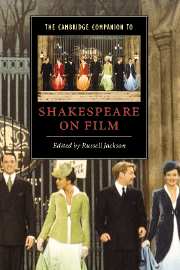Book contents
- Frontmatter
- Introduction
- PART 1 ADAPTATION AND ITS CONTEXTS
- PART 2 GENRES AND PLAYS
- 5 The comedies on film
- 6 Filming Shakespeare's history: three films of Richard III
- 7 Hamlet, Macbeth and King Lear on film
- 8 The tragedies of love on film
- PART 3 DIRECTORS
- PART 4 CRITICAL ISSUES
- Further reading
- Filmography
- Index
7 - Hamlet, Macbeth and King Lear on film
from PART 2 - GENRES AND PLAYS
Published online by Cambridge University Press: 28 May 2006
- Frontmatter
- Introduction
- PART 1 ADAPTATION AND ITS CONTEXTS
- PART 2 GENRES AND PLAYS
- 5 The comedies on film
- 6 Filming Shakespeare's history: three films of Richard III
- 7 Hamlet, Macbeth and King Lear on film
- 8 The tragedies of love on film
- PART 3 DIRECTORS
- PART 4 CRITICAL ISSUES
- Further reading
- Filmography
- Index
Summary
Ask the man on the street what comes to mind when you mention 'Shakespeare', and the chances are that he will reply, 'to be, or not to be'. We have come to associate Shakespeare with tragedy, especially with Hamlet, and in fact the first century of Shakespeare on film began with Hamlet, in the form of a five-minute film directed by Maurice Clément and shown at the Paris Exhibition in 1900. It starred Sarah Bernhardt as Hamlet and Pierre Magnier as Laertes. The predominance of the tragedies on screen until 1990 is confirmed by Kenneth Rothwell's and Annabelle Melzer's definitive filmography and videography that lists 184 entries for Hamlet, Macbeth and King Lear, i.e. 27 per cent of the total entries, even though they comprise only 8 percent of Shakespeare's work. Not surprisingly the film adaptations of the tragedies have received the most attention from (predominantly male) film critics as well. How and why Shakespearean tragedy on film has been able to transcend the temporal, national, ideological and cultural boundaries of Elizabethan England, even without Shakespeare's language, will be the question I am going to pursue.
‘Who’s there?’: the question of Fortinbras
Hamlet opens with a question, ‘Who’s there?’ and by the the time the play has ended, more questions have been raised than answered. The opening question also points to the end of the play when Fortinbras enters to clear the stage of carnage and assume the throne as Hamlet’s successor. It suggests that there is a circularity in the play and that Fortinbras may have been more important to Shakespeare than he has been to some directors.
- Type
- Chapter
- Information
- The Cambridge Companion to Shakespeare on Film , pp. 117 - 134Publisher: Cambridge University PressPrint publication year: 2000



